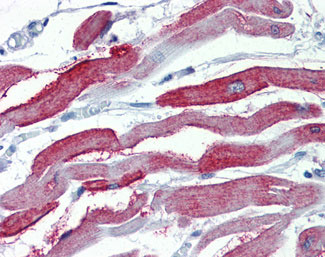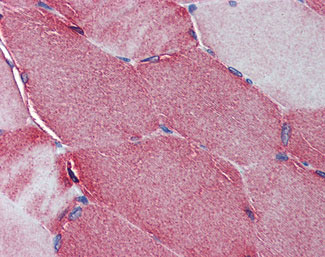Junctophilin 2 / JPH2 Antibody (C-Terminus)
Rabbit Polyclonal Antibody
- SPECIFICATION
- CITATIONS
- PROTOCOLS
- BACKGROUND

Application
| WB, IHC-P, E |
|---|---|
| Primary Accession | Q9BR39 |
| Reactivity | Human, Mouse, Rat |
| Host | Rabbit |
| Clonality | Polyclonal |
| Calculated MW | 74kDa |
| Dilution | IHC-P (5 µg/ml), WB (1-2 µg/ml), |
| Gene ID | 57158 |
|---|---|
| Other Names | Junctophilin-2, JP-2, Junctophilin type 2, JPH2, JP2 |
| Target/Specificity | Multiple isoforms of JPH2 are known to exist. |
| Reconstitution & Storage | Short term 4°C, long term aliquot and store at -20°C, avoid freeze thaw cycles. Store undiluted. |
| Precautions | Junctophilin 2 / JPH2 Antibody (C-Terminus) is for research use only and not for use in diagnostic or therapeutic procedures. |
| Name | JPH2 (HGNC:14202) |
|---|---|
| Function | [Junctophilin-2]: Membrane-binding protein that provides a structural bridge between the plasma membrane and the sarcoplasmic reticulum and is required for normal excitation-contraction coupling in cardiomyocytes (PubMed:20095964). Provides a structural foundation for functional cross-talk between the cell surface and intracellular Ca(2+) release channels by maintaining the 12-15 nm gap between the sarcolemma and the sarcoplasmic reticulum membranes in the cardiac dyads (By similarity). Necessary for proper intracellular Ca(2+) signaling in cardiac myocytes via its involvement in ryanodine receptor-mediated calcium ion release (By similarity). Contributes to the construction of skeletal muscle triad junctions (By similarity). |
| Cellular Location | [Junctophilin-2]: Cell membrane {ECO:0000250|UniProtKB:Q9ET78}; Peripheral membrane protein {ECO:0000250|UniProtKB:Q9ET78}. Sarcoplasmic reticulum membrane {ECO:0000250|UniProtKB:Q9ET78}; Single-pass type IV membrane protein {ECO:0000250|UniProtKB:Q9ET78}. Endoplasmic reticulum membrane {ECO:0000250|UniProtKB:Q9ET78}; Single-pass type IV membrane protein {ECO:0000250|UniProtKB:Q9ET78}. Note=The transmembrane domain is anchored in sarcoplasmic reticulum membrane, while the N-terminal part associates with the plasma membrane. In heart cells, it predominantly associates along Z lines within myocytes. In skeletal muscle, it is specifically localized at the junction of A and I bands {ECO:0000250|UniProtKB:Q9ET78} |
| Tissue Location | Specifically expressed in skeletal muscle and heart. |

Thousands of laboratories across the world have published research that depended on the performance of antibodies from Abcepta to advance their research. Check out links to articles that cite our products in major peer-reviewed journals, organized by research category.
info@abcepta.com, and receive a free "I Love Antibodies" mug.
Provided below are standard protocols that you may find useful for product applications.
Background
Junctophilins contribute to the formation of junctional membrane complexes (JMCs) which link the plasma membrane with the endoplasmic or sarcoplasmic reticulum in excitable cells. Provides a structural foundation for functional cross-talk between the cell surface and intracellular calcium release channels. JPH2 is necessary for proper intracellular Ca(2+) signaling in cardiac myocytes via its involvement in ryanodine receptor-mediated calcium ion release. Contributes to the construction of skeletal muscle triad junctions.
References
Stavrides G.S.,et al.Submitted (NOV-1999) to the EMBL/GenBank/DDBJ databases.
Deloukas P.,et al.Nature 414:865-871(2001).
Mural R.J.,et al.Submitted (SEP-2005) to the EMBL/GenBank/DDBJ databases.
Nishi M.,et al.Biochem. Biophys. Res. Commun. 273:920-927(2000).
Olsen J.V.,et al.Cell 127:635-648(2006).
If you have used an Abcepta product and would like to share how it has performed, please click on the "Submit Review" button and provide the requested information. Our staff will examine and post your review and contact you if needed.
If you have any additional inquiries please email technical services at tech@abcepta.com.













 Foundational characteristics of cancer include proliferation, angiogenesis, migration, evasion of apoptosis, and cellular immortality. Find key markers for these cellular processes and antibodies to detect them.
Foundational characteristics of cancer include proliferation, angiogenesis, migration, evasion of apoptosis, and cellular immortality. Find key markers for these cellular processes and antibodies to detect them. The SUMOplot™ Analysis Program predicts and scores sumoylation sites in your protein. SUMOylation is a post-translational modification involved in various cellular processes, such as nuclear-cytosolic transport, transcriptional regulation, apoptosis, protein stability, response to stress, and progression through the cell cycle.
The SUMOplot™ Analysis Program predicts and scores sumoylation sites in your protein. SUMOylation is a post-translational modification involved in various cellular processes, such as nuclear-cytosolic transport, transcriptional regulation, apoptosis, protein stability, response to stress, and progression through the cell cycle. The Autophagy Receptor Motif Plotter predicts and scores autophagy receptor binding sites in your protein. Identifying proteins connected to this pathway is critical to understanding the role of autophagy in physiological as well as pathological processes such as development, differentiation, neurodegenerative diseases, stress, infection, and cancer.
The Autophagy Receptor Motif Plotter predicts and scores autophagy receptor binding sites in your protein. Identifying proteins connected to this pathway is critical to understanding the role of autophagy in physiological as well as pathological processes such as development, differentiation, neurodegenerative diseases, stress, infection, and cancer.



